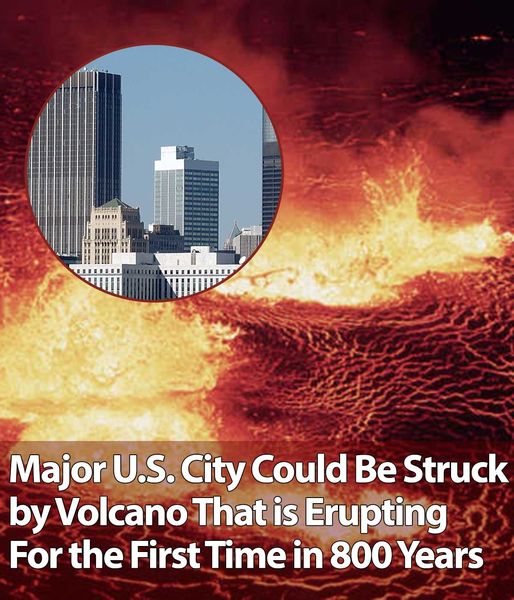For nearly 800 years, Mount Edgecumbe, a towering volcano located near Sitka, Alaska, has slept peacefully, offering no signs of the fiery turmoil beneath its surface. However, recent scientific observations suggest that this dormant giant may be on the brink of a rare and potentially catastrophic eruption.
Signs of Impending Eruption

Volcanologists have reported increasing activity beneath Mount Edgecumbe, indicating that magma is on the move deep within the Earth’s crust. “We’ve been closely monitoring the volcano, and the signs are there — magma movement, seismic activity, ground deformation,” said Hannah Dietterich, a research geophysicist at the Alaska Volcano Observatory. “It’s something we haven’t seen in this region for centuries.”
Dormant Volcanoes: A Hidden Threat

While active volcanoes like Mount Etna and Mount Stromboli in Italy frequently capture headlines, dormant volcanoes often slip under the radar. However, as Dietterich explains, “Even a volcano that hasn’t erupted in centuries can still pose a significant threat. Dormancy doesn’t mean safety; it means unpredictability.”
Mount Edgecumbe’s Past Eruptions

Mount Edgecumbe last erupted 800 years ago, with evidence of an earlier eruption around 1,150 years ago. According to a 2010 research paper, a similar eruption today could endanger nearby population centers. “The risk is real,” said Dietterich. “An eruption like the one 800 years ago would have devastating consequences for the local communities.”
Life on the Mountain: A Historical Perspective

The indigenous Tlingit people, who have lived near Mount Edgecumbe for centuries, called the mountain L’ux, meaning “flash” or “blinking.” This name likely originates from their ancestors witnessing volcanic activity. Today, the mountain is surrounded by modern residents who have never experienced such a threat.
Magma on the Move: A Warning Sign

Over the past few years, studies have confirmed that magma is shifting beneath Mount Edgecumbe. “This is a clear indication that an eruption could occur,” said Dietterich. However, she cautioned that there’s also a possibility that the magma will remain trapped beneath the surface, posing no immediate danger.
Earthquakes and Volcanic Unrest

In 2022, a series of small earthquakes around Mount Edgecumbe caught the attention of scientists. These quakes, though minor, were significant enough to influence the volcano’s magma chamber. “We’ve seen gas bubbling from the ground and the land bulging upwards — all signs of potential volcanic activity,” Dietterich noted.
Read More: Tourist Dies, Falling 250ft Into Active Volcano After Trying to ‘Pose for Pictures’
The Role of Seismometers in Monitoring

To better understand and predict the behavior of Mount Edgecumbe, scientists have installed seismometers around the volcano. These sensitive instruments can detect even the smallest earthquakes, providing crucial data to researchers. “The seismometers are our eyes and ears,” said Dietterich. “They allow us to monitor the volcano’s activity in real-time.”
The Calm After the Quakes

Fortunately, seismic activity around Mount Edgecumbe has decreased since 2022. “While this is reassuring, it doesn’t eliminate the risk entirely,” Dietterich explained. The new instruments installed by the Alaska Volcano Observatory will continue to monitor the situation closely.
A Unique and Mysterious Volcano

Mount Edgecumbe is unlike any other volcano in Alaska. Satellite radar measurements show that the ground near the volcano is bulging outward at a faster rate than any other volcano in the state. “This is unusual and makes Edgecumbe a unique case,” said Dietterich.
Cutting-Edge Technology for Accurate Tracking

The newly installed ground sensors around Mount Edgecumbe are equipped with the latest technology, allowing scientists to track changes in the volcano hour by hour. “This technology is far more accurate than relying on satellite data alone,” Dietterich said. “It’s a game-changer for monitoring volcanic activity.”
Gas Emissions: A Clue to the Volcano’s Future

In addition to seismic monitoring, scientists have been investigating gas emissions near Mount Edgecumbe. “We recently analyzed gas samples for any signs that they are linked to the magma,” Dietterich explained. While the results are still under review, they could provide vital clues about the volcano’s future behavior.
Read More: Why don’t we dump our trash into a volcano? The fiery science explained
A History of False Alarms

Mount Edgecumbe has been the subject of eruption rumors before. In 1974, a prankster set tires on fire around the volcano, causing black smoke to rise and sparking fears of an imminent eruption. This time, however, the threat is real, and scientists are taking it seriously.
Mount Rainier: Another Dormant Threat

Mount Edgecumbe isn’t the only volcano causing concern. Based in Washington state, it’s remained dormant for over 1,000 years and is also under close observation. Volcanologists worry that it too could erupt, potentially putting thousands of lives at risk.
Seismometers: The First Line of Defense

The seismometers installed around Mount Edgecumbe offer a vital early warning system. “If there’s any change in the volcano’s activity, we’ll know immediately,” Dietterich assured. This gives residents and authorities valuable time to prepare for any potential eruption.
Magma Movement Doesn’t Guarantee Eruption

Despite the movement of magma beneath Mount Edgecumbe, an eruption isn’t guaranteed. “We’ve seen many cases where magma rises but never breaches the surface,” said Dietterich. “It’s a reminder that volcanic behavior is complex and unpredictable.”
Research Opportunities Amidst the Threat

The new monitoring equipment around Mount Edgecumbe isn’t just for safety; it also opens up new research opportunities. “This is the first time we’ve had such detailed instruments on Edgecumbe,” Dietterich noted. “It’s a chance to learn more about this unique volcano.”
Outside the Hotspot: Edgecumbe’s Unusual Location

Mount Edgecumbe’s location makes it an anomaly among Alaska’s volcanoes. Unlike most of the state’s active volcanoes, which lie along a tectonic plate boundary, Edgecumbe sits outside of Alaska’s volcanic hotspot. “This could lead to fascinating geological discoveries,” Dietterich said.
A Waiting Game

As scientists continue to monitor Mount Edgecumbe, the residents of Sitka and the surrounding areas are left to wait. “We’re doing everything we can to keep people safe,” Dietterich said. “But in the end, it’s nature that will have the final say.”
